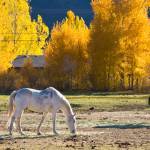Sand for Horses: The Bad and the Good

Most horse owners have heard about sand colic. This problem can occur when horses graze on forage growing in loose, sandy soil. Sand particles cling to the roots and stems of ingested plants, and this heavy, indigestible material can accumulate in the horse’s gut. With some horses, a small amount of sand causes recurrent signs of colic. Other horses seem to tolerate a moderate load of intestinal sand with no problems. In any case, there is a potential danger associated with this grazing scenario.
Sand and horses can be a good mix, however. If you have a drylot, small turnout paddock, or bare pasture area, you can spread a truckload of sand to provide a favorite place for horses to roll. For a six-inch-deep rolling pad about ten feet long and ten feet wide, you will need to order about 2.5 to three tons of sand from a farm supply, concrete, or construction company. Chances are, the cost of having it delivered will exceed the cost of the sand itself, but it’s still not terribly expensive to obtain. The truck will dump it in a large pile that you’ll need to spread, though the horses will eventually spread it themselves if you don’t want to get a shovel out.
Something about the feel of sand encourages horses to lie down and roll, an activity that they seem to enjoy. There’s no down-side to having a sand pile available to your horses as long as you take several precautions. First, be sure the sand has not come from an ocean beach because the salty smell and taste may tempt horses to eat it. Second, don’t place piles of hay on the sand; this simulates grazing on sandy soil. Last, regularly pick up manure from the sandy spot to avoid having horses roll in droppings.
Over time, the rolling pad will need to be renewed as sand blows away, gets spread out, or is worked down into the soil. In the meantime, it will provide some entertainment for your horses, and it also helps to remove hair during shedding season, making your grooming chores a bit easier.








